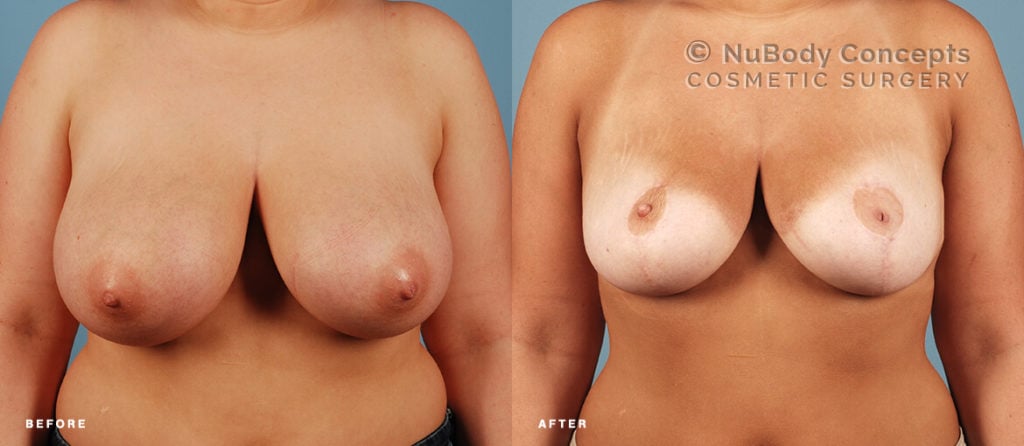Breast reductions are relatively common plastic surgery procedures, with around 500,000 of them performed worldwide every year. They are a good option for women who are unhappy with the large size of their breasts or who experience physical discomfort due to the heavy weight of their breasts. Breast reduction surgery (also called reduction mammaplasty) removes excess fat, glandular tissue and skin to achieve a breast size that is more in proportion with the body.

Can you have a breast reduction before having children? Many younger women who have not had children yet or are not done having children can benefit from a breast reduction, especially if their large breasts are causing discomfort or even pain. Whether or not it’s possible to breastfeed children after a breast reduction is an important question to consider before proceeding.
In short, it is possible to breastfeed after a breast reduction, but there are several topics you should explore and that we will cover in this article:
- Educating yourself about breast feeding after reduction (also referred to as BFAR).
- Making sure you understand the techniques for preserving the ability to breastfeed.
- Understanding how milk ducts work and how they can reconnect during lactation.
Can You Breast Feed After a Breast Reduction?
What should I know about Breast Feeding After Reduction (BFAR)?
Breast feeding after reduction – BFAR – is a hotly debated topic, and it is surprisingly difficult to get a definite answer on how it is affected. One of the reasons is that plastic surgeons, like most doctors, are reluctant to give any kind of guarantee about the outcome. Another is that things have vastly improved in recent history.
If you are considering a breast reduction, you may want to spend some time reading up on this topic. The benefits of breastfeeding newborns are well-documented, and you don’t want to forgo that option with a decision you might make as a teenager.
As breast surgery in general has become more commonplace among women, plastic surgery techniques have evolved and become more fine-tuned. While ten or twenty years ago many women did indeed struggle to breastfeed after having a reduction, this no longer seems to be the case. Today’s surgeons mostly use techniques that focus on preserving the nipple and attached milk ducts.
Using the right surgical technique for a breast reduction
A 2017 study shows that the key to preserve the ability to breastfeed after a reduction is the so-called “preservation of the column of subareolar parenchyma” – the lactating part of the gland under the areola. “The median breastfeeding success was 4% for techniques with no preservation, compared to 75% for techniques with partial preservation and 100% for techniques with full preservation.” As you can see, it is very important to ask your plastic surgeon what degree of preservation he intends to employ.
“There are certain number of women who just cannot breastfeed”
Dr. John Rosdeutscher, NuBody Concepts Brentwood
It is worth keeping in mind that the ability to breastfeed is not a given even under perfect conditions. “There are certain number of women who just cannot breastfeed, and just because you have been able to before does not guarantee that you will be able to again,” says Dr. John Rosdeutscher, double-board certified plastic surgeon at NuBody Concepts in Nashville.
Women who have breastfed several children can attest to the fact that breastfeeding success can vary wildly from child to child. Even if you’ve taken all the precautions and opted for a breast reduction with full preservation of the milk ducts, you still may find yourself struggling with breastfeeding – your surgery may have nothing to do with it.
In general, a woman’s milk supply tends to increase with each pregnancy, so that even if you struggled with your first child, it may be easier with your second, etc. Also, not all women have the same number of ducts. You may already start out with fewer milk ducts than other women, so that having one of the few severed would be a much bigger loss.
Do milk ducts grow back after a breast reduction?
On the other hand, even if one or more of your milk ducts became severed during breast reduction surgery, some of these ducts can reconnect during lactation so that the milk can flow. This is called recannulization. The act of lactating can trigger this recannulization so that over time more milk might flow.
It’s also good to know that breast engorgement during pregnancy and breastfeeding is normal. Don’t worry that this might be somehow caused by your surgery – it isn’t. It’s part of the natural child-bearing cycle, and your breasts will return to their smaller size once you wean your child. You may also experience a difference in breast size due to different amounts of milk coming in. Again, this has nothing to do with a previous breast reduction and rather is something most breastfeeding women experience.
As we’ve said before, no plastic surgeon will pronounce a 100% guarantee. If you want to be absolutely sure that your breast reduction will not affect your ability to breastfeed, then you should wait.
What happens if you have a baby after a breast reduction?
“Unless extenuating circumstances are present, breast-reduction surgery is best done after completion of child-bearing,” says Dr. Rosdeutscher. And he has another word of caution for very young women: The younger a breast reduction is done, the more likely the woman will need another in her lifetime.
In the end, it’s a matter of weighing different needs and wants. Your discomfort with heavy breasts might be so intense that it warrants the calculated breastfeeding risks we’ve outlined above. It is also worth noting that breastfeeding doesn’t have to be all-or-nothing. You may decide that it is worth feeling good about yourself and being able to run and exercise without discomfort, if in return that means that you may only be able to supply breast-milk to your infant part of the time.
The best way to decide whether a breast reduction is for you is to schedule a consultation with a plastic surgeon to discuss your specific goals. Click below to contact us or to schedule a consultation with a plastic surgeon.
References: The impact of breast reduction surgery on breastfeeding: Systematic review of observational studies.












